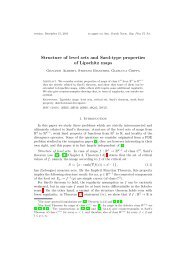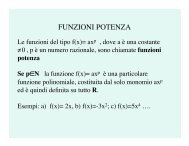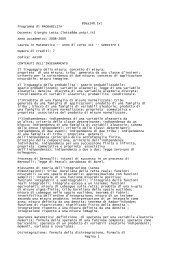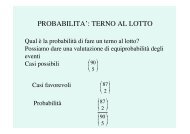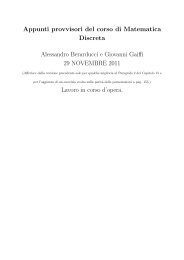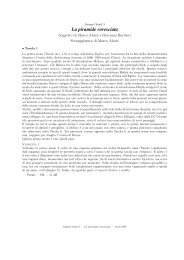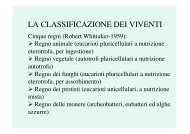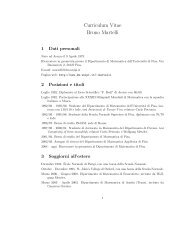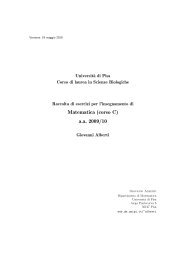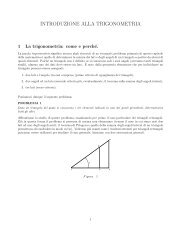Immersioni aperte in dimensione infinita - Dipartimento di Matematica
Immersioni aperte in dimensione infinita - Dipartimento di Matematica
Immersioni aperte in dimensione infinita - Dipartimento di Matematica
Create successful ePaper yourself
Turn your PDF publications into a flip-book with our unique Google optimized e-Paper software.
2.1 Introduzione 23<br />
applicazione ξ U : U → H. Similmente, se S è un fissato campo <strong>di</strong> vettori del second’ord<strong>in</strong>e su M<br />
(cfr. def<strong>in</strong>izione F.1), <strong>in</strong><strong>di</strong>cheremo con S U : U × H → H × H la rappresentazione locale <strong>di</strong> S su T U:<br />
S U (x, v) = v, s U (x, v) .<br />
T T M loc <br />
<br />
<br />
<br />
U × H × (H × H)<br />
<br />
T M<br />
<br />
<br />
<br />
loc <br />
<br />
<br />
<br />
<br />
U × H<br />
Id U×H ×S U<br />
A tale proposito si ricor<strong>di</strong> che S U rappresenta uno spray se e solo se la sua parte pr<strong>in</strong>cipale<br />
s U : U × H → H è omogenea <strong>di</strong> grado due rispetto alla seconda variabile (cfr. proposizione F.9).<br />
Per questa ragione s U è detta anche la parte quadratica dello spray nella carta assegnata.<br />
Siano S ed A rispettivamente uno spray ed un atlante layer su M. Consideriamo una carta locale<br />
(V, ψ) compatibile con tutte le carte <strong>di</strong> A. In<strong>di</strong>cata con (U, ϕ) una qualsiasi carta <strong>di</strong> A, poiché (V, ψ)<br />
e (U, ϕ) sono compatibili, identificati per semplicità <strong>di</strong> notazione U e V con le rispettive immag<strong>in</strong>i <strong>in</strong><br />
H tramite ϕ e ψ, <strong>in</strong> accordo con la def<strong>in</strong>izione 2.14 <strong>di</strong> varietà layer, esiste un <strong>di</strong>ffeomorfismo h da U<br />
su V della forma h = (I + k), <strong>in</strong> cui k è una mappa localmente <strong>di</strong> rango f<strong>in</strong>ito. Per la formula F.3.8<br />
<strong>di</strong> cambiamento <strong>di</strong> variabile per la parte quadratica <strong>di</strong> uno spray (si consulti la sottosezione F.3.2<br />
<strong>in</strong> appen<strong>di</strong>ce per la sua deduzione esplicita) risulta<br />
′ ′′ ′<br />
sV h(x), h (x)(v) = h (x)(v, v) + h (x) ◦ sU (x, v). (2.1.1)<br />
In particolare h ′ (x) = I + k ′ (x) e h ′′ (x) = k ′′ (x). Inoltre, posto (y, w) <strong>in</strong> V × H con y = h(x) e<br />
w = h ′ (x)(v) se e solo se v = (h−1 ) ′ (y)(w) , l’equazione 2.1.1 assume la forma<br />
′ ′′ ′<br />
h(x), h (x)(v) = h (x)(v, v) + h (x) ◦ sU (x, v)<br />
s V (y, w) = s V<br />
= k ′′ (x)(v, v) + s U (x, v) + k ′ (x) ◦ s U (x, v),<br />
da cui si deduce che, essendo k una mappa localmente <strong>di</strong> rango f<strong>in</strong>ito, se s U è localmente <strong>di</strong> rango<br />
f<strong>in</strong>ito allora tale è anche s V .<br />
Def<strong>in</strong>izione 2.20 (Spray layer). Sia M una varietà modellata su uno spazio <strong>di</strong> Hilbert H. Uno<br />
spray S su M è detto uno spray layer se esiste un atlante layer A = {(Ua, ϕa)} a∈A su M tale che,<br />
per ogni a <strong>in</strong> A, <strong>in</strong><strong>di</strong>cata con Sa la rappresentazione locale <strong>di</strong> S nella carta (Ua, ϕa),<br />
Sa : (x, v) ∈ ϕ a(Ua) × H ↦−→ v, s a(x, v) ∈ H × H,<br />
SL. s a : ϕ a(Ua) × H −→ H è localmente <strong>di</strong> rango f<strong>in</strong>ito <strong>in</strong> x<br />
(i.e., per ogni x <strong>in</strong> ϕa(Ua) esiste x∈Ux Ux Ux ⊂ϕa(Ua) tale che sa(Ux ×H) ⊂ Hn per qualche n ∈ N).<br />
Proposizione 2.21. Ogni H-varietà layer M ammette uno spray layer.<br />
Dimostrazione. In<strong>di</strong>cato con A = {(Ua, ϕa)} a∈A un atlante layer su M, poiché M è supposta paracompatta,<br />
senza ledere la generalità, a meno <strong>di</strong> un raff<strong>in</strong>amento possiamo supporre che {Ua} a sia un<br />
ricoprimento localmente f<strong>in</strong>ito <strong>di</strong> M: sia {µa} una partizione dell’unità <strong>di</strong> classe C∞ subord<strong>in</strong>ata a<br />
{Ua} a. Nelle notazioni della def<strong>in</strong>izione 2.20, per ogni a <strong>in</strong> A lo spray banale Sa su ϕa(Ua) def<strong>in</strong>ito<br />
ponendo<br />
Sa : (x, v) ∈ ϕa(Ua) × H ↦−→ Sa(x, v) : def<br />
= v, O ∈ H × H<br />
è certamente layer. Incolliamo dunque spray banali siffatti secondo la partizione dell’unità {µa}<br />
ottenendo così una mappa globale S : T M → T (T M). La mappa così ottenuta è <strong>in</strong>vero uno spray,<br />
<strong>in</strong>fatti la collezione <strong>di</strong> tutti gli spray costituisce un <strong>in</strong>sieme convesso, dunque <strong>in</strong> ogni punto della<br />
varietà la somma che def<strong>in</strong>isce S è uno spray perché comb<strong>in</strong>azione convessa <strong>di</strong> spray. Più precisamente,<br />
S è uno spray layer, <strong>in</strong>fatti la somma che def<strong>in</strong>isce S è localmente f<strong>in</strong>ita, i.e. nell’<strong>in</strong>torno <strong>di</strong><br />
ogni punto <strong>di</strong> M solo un numero f<strong>in</strong>ito <strong>di</strong> adden<strong>di</strong> è non nullo, e poiché ciascuno <strong>di</strong> essi sod<strong>di</strong>sfa la<br />
con<strong>di</strong>zione SL anche la loro somma sod<strong>di</strong>sfa certamente SL.<br />
RAUL TOZZI



